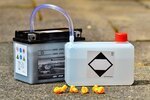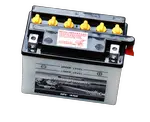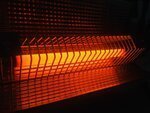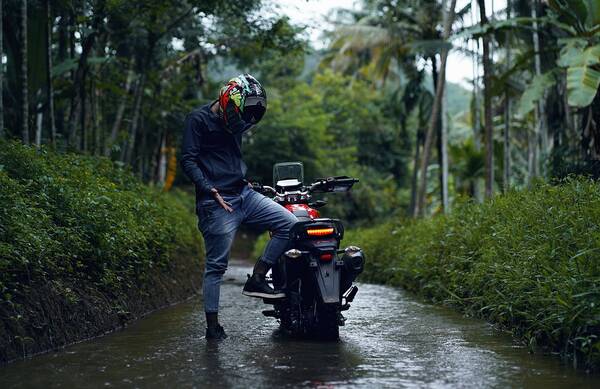Have you left your motorcycle stranded in rain and now it’s not starting? Want to know how to start a motorcycle after rain? It is as if the battery is entirely dead or something. But how could that be possible because you left it in a meticulous condition?
It’s a common problem that riders experience after a heavy spell of rain. Nothing can be more frustrating when you find your bike dead when you take it out for a ride. Starting your bike after rain is just like cold starting it. Batteries don’t perform well in low temperatures.
Your bike can be robust but still vulnerable to weather and road conditions. Too much heat or wet weather conditions can affect your motorbike. Therefore, when you see a lot of rain and get your bike out for a ride, be careful.
We have developed this guide to tackle how to start a motorcycle after rain comfortably to get you through this problem.
Why Doesn’t a Bike Start After Rain?
Well, after the rain, it is just like cold starting in the winter season. Your battery will face some problems when you try to start it in chilly or damp. The surrounding air needs to be in an acceptable range in terms of temperature and humidity to ensure the battery is in the proper state to produce the spark.
Rain causes the temperature to drop a bit, and when there is too much dampness in the air, the oil inside the engine contracts and becomes less likely to flow.
Most motorcycles come with 12V batteries, but it is slightly more than that when fully charged. A fully charged battery is around 12.6V incapacity. Your bike’s alternator keeps your battery charged at a much higher value as well. And your battery becomes 14V incapacity in that scenario.
Measuring the volts on your battery might not count a lot towards how to start a motorcycle in the rain. But cold-cranking amps or CCA are more relevant in this scenario. These values are critical to ensure your bike has enough juice when you need to start it.
Cold-cranking amps

Cold-cranking amps or CCA determine your bike’s ability to start the engine when the temperatures are low. It’s the amount of current that your battery can produce. There is a difference between amps and volts. Volts if a battery is like the amount of water in a hose while amps are like the size of a hose.
When you decrease the size of the hose, you will be able to increase the speed of water flow. And when you take it into account, you need more water or charge in the hose to start it up. If there is not enough voltage there, you won’t be able to start the bike. Apart from that, your battery must also be able to produce enough current as well.
With the drop in surrounding temperature, your battery’s CCA begins to get affected. And this becomes especially the case if your battery is old. Even if a battery is fully charged, it won’t turn the engine over in such a scenario.
Engine Oil

Oil is equally affected with cold temperature as it is rated for specific weight and weather as well. You will notice the engine oil has a different climate and weight ratings like 5W-20, 0W-30, etc.
The weight rating hair doesn’t refer to pounds of kilograms. It refers to the thickness and flow of that particular oil at that specific temperature. As your engine starts and the oil heats up, it will begin to thin down, but when it cools, it becomes thicker.
When rain occurs, the surrounding temperature cools down a bit while it drops the overall flow rate of your engine oil. When you start the engine, the oil doesn’t flow quickly and doesn’t make the engine turn over.
How to Start a Motorcycle After Rain?
So, how to start a motorcycle after rain? You will notice that your engine will take some time to begin whenever the temperature outside drops down a bit or it’s raining. You might have already tried a few ways to get the job done, and some of them might have worked while others might haven’t. But here are some sure-shot steps that you can take to get your engine running in no time.
Battery condition

You need to make sure your battery is in good condition. It needs to have enough juice inside it to make sure it can pick the spark up and start your engine. You have to make sure it’s not an old battery.
An old battery causes a lot more problems during wet or cold conditions. It is not going to turn the engine over if it is ancient. Therefore, you need to make sure you are using a new battery and in good condition. You can also invest in a multimeter and check to see it has at least 12.2V on it to turn your engine over.
Improving the surroundings
You can also make sure to warm up your engine by providing it with warm surroundings. You can always use a space heater for this purpose. Just place a space heater right next to your engine but at a safe distance to blow warm air on the engine for some minutes. It will evaporate any moisture in the surrounding air and make the air dry and warm so the engine can comfortably turn over.
Preventing Starting Issues When It’s Cold and Wet Outside
The first thing you have to do is not ride during wet or cold days because the conditions are less than ideal for you to ride and for your bike. But if you are a committed rider throughout the year, you need to take some preventive measures. It’s a bit tough in these conditions because you need to do some prep work to begin the ride.
Keep Motorcycle indoors

You need to make sure you keep your bike indoors when you are not riding it. Storing it indoors will keep its exposure to moisture and cold on the lower side. A garage would be the ideal option, but even a shelter will work in this scenario. Just try to keep it out of moist wind or rain. Your engine will remain dry, and it will become easier for the batteries to turn it over when you need it.
Use a space heater

Another way of getting the job done is by using a space heater. You can use a space heater to keep it in dry condition right before you start the engine. This is probably the best way how to start a motorcycle after rain.
The thing is, you need to keep the conditions warm for your engine. It will make sure that the oil inside the engine remains warm and more fluid, and thin. Therefore, when you go to start your bike, it will turn the engine over. The battery also needs to have enough charge on it.
Properly charged battery
You need to make sure the battery remains charged at all times. It would be better to invest in a voltmeter and check your battery’s charge before starting it. Your battery needs to be at 12.2V to produce enough current to turn the engine over. If it is not charged correctly, you need to charge it properly to turn the engine over properly.
Use covers outdoors
When you are bound to park it outdoors, it would be better to keep it under covers. You will have to make sure you go for a rainproof or weather-resistant cover that will keep the moisture off your bike. It will also prevent the engine from getting too cold and allow you to start and turn the engine over in no time.
Take Care of Your Bike Properly
You have to take care of your bike properly and make sure you keep it in a well-maintained position at all times. Replace all old components and parts on your bike, especially if you are a committed rider.
How to start a motorcycle after rain is the matter of keeping it in new conditions at all times. Your engine and all its components must be properly lubricated at all times. The engine oil must be appropriately replaced according to the set schedule, and you also need to keep the battery in the right shape at all times if you are going to get the best experience from your ride.
It would be better to check your bike before every ride to ensure you can tackle any issue before it even occurs. This way, you will be able to ride your bike whenever you take it out for a ride without any unpleasant surprises.
Conclusion
Having trouble starting your bike after rain? How to start a motorcycle after rain is something you need to take very seriously if you are looking to avoid the frustration of spending hours turning your engine over right before you take it out for a ride. Following the steps mentioned above will avoid wasting any time, and you will continue to enjoy the beautiful weather, not only after the rain but also during it.


